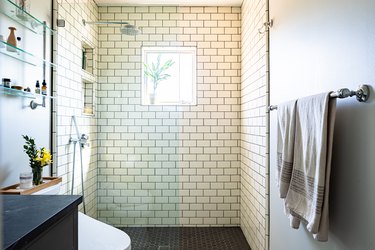Installing a toilet paper holder, a safety grasp bar in the shower, or new bathroom fixtures into a ceramic wall or countertop requires some skill and specific tools. If not done correctly, the ceramic tiles can crack, and the grout can crumble or break away.
Grout isn't as stable and strong as tile, and drilling into tile grout isn't recommended. However, if you can't get around it because you have to install a fixture or the like, then there are a few ways to do it successfully.
Video of the Day
Video of the Day
Safety Precautions for Drilling
When using a power drill, wear protective gear. Safety glasses and a good particle mask can protect you from the fine dust particles that will fly up from the surface and irritate your eyes, nose and lungs. Work gloves can ensure that you have a good grip on the drill as well as the slippery tile surrounding the grout with which you are working.
A carbide-tipped masonry drill bit and a steady hand can drill through ceramic or glazed tile without breaking the brittle material. A diamond-tipped drill bit is more expensive but can get through hard stone, porcelain, quarry tiles, full-bodied and vitrified porcelain as well as fragile ceramic tiles swiftly. It also won't burn out as easily as a carbide-tipped masonry drill bit. Drill bits can heat up quickly, particularly when working with hard stone or quarry tiles. Have a few on hand so that you can change them out if they heat up.
Baggy clothes can be a hindrance when working with power tools of any kind. Loose pants and sleeves can get caught up in the moving drill bit. To be safe, remove jewelry and fasten your hair under a cap or use a hair tie so that it doesn't swing in your face or end up winding around the end of the drill in action.
Measure and Mark the Area
To be sure that you don't have to take a second chance on breaking the tile or grout line by drilling a second time, measure the area twice. Mark it with a piece of masking tape after the first measure and measure again.
The masking tape gives the drill bit something to work with over the slick surface. Tile is slippery, so the more measures you have in place for the drill bit to get a good grip, the fewer chances you have of scratching or damaging the surrounding tile. A drill guide can increase the accuracy and help protect surrounding tiles and grout.
How to Drill Into Grout and Tile
Whenever possible, try to drill into the grout that is located on top of a wall stud. Use a stud finder to locate a stud behind the area you plan to drill, and if you can't find one, use a wall anchor when drilling through grout. Screws aren't able to get a good hold in the porous material and will eventually slip out.
Low and slow is the best for drilling into tile and grout, so set the drill to between 100 and 200 rpm. Place the drill on the mark and gently begin to drill. Keep a steady hand. If the drill bit begins to overheat, put a cold cloth on the bit and allow it to cool down for a few minutes before resuming drilling or change it out for a fresh bit. Release the drill trigger only when the bit is clear from the grout or tile to reduce the risk of the grout or tile cracking.
